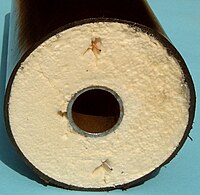Flexible composite pipe
In composite flexible pipes is factory-fitted with thermal insulation pipes for transporting hot-continuous media, especially water; seldom also for cold media. Flexible composite pipes are typically used in local and district heating networks and are usually laid directly in the ground. To bridge longer distances, stiff plastic jacket composite pipes are used as an alternative, especially in district heating networks.
The medium pipe consists either of mild steel , copper , multilayer composite , cross-linked polyethylene , polybutene-1 or of corrugated pipe made of stainless steel . The thermal insulation consists of flexible polyurethane foam , more rarely also polyisocyanurate foam , and the jacket pipe is made of polyethylene or corrugated sheet steel, which is coated on the outside with polyethylene.
Media pipes made of metal are usually designed for operating pressures of up to 1.6 MPa (16 bar, corresponds to PN16), media pipes made of plastic are usually designed for operating pressures of up to 600 kPa (6 bar, corresponding to PN6), whereby this pressure applies to the upper continuous operating temperature limit. The upper limit temperature for continuous operation is determined by the thermal insulation of metal media pipes and is approx. 140 ° C for polyurethane foam and approx. 160 ° C for polyisocyanurate foam. In the case of media pipes made of plastic, the upper limit temperature for continuous operation is determined by the material of the media pipe itself and is approx. 90 ° C.
The jacket pipe protects the thermal insulation from external influences. The polyurethane foam thermal insulation bears the weight of the filled media pipe and creates a non-positive bond between the medium pipe, thermal insulation and jacket pipe. This bond absorbs the forces caused by the heating of the pipeline and diverts it into the ground.
The usual dimensions of plastic media pipes are in the range from 25 × 2.3 to 160 × 14.6 for PN6. Larger wall thicknesses are required for the media pipes of nominal pressure levels PN8 and PN10, which are used less frequently. Usual dimensions of media pipes made of copper are 15 to 54 mm outside diameter, media pipes made of mild steel with 20 to 28 mm outside diameter and media pipes made of corrugated stainless steel with 14 to 197 mm inside diameter.
Flexible composite pipes are supplied as rolls and, like cables, are usually laid directly from the drum. Lengths up to approx. 50 m in medium pipes of small dimensions, e.g. B. are required for house connections, are also delivered to the construction site as coils. The connections to be made on the construction site are limited to the connections and, if necessary, branches and connections between two drum lengths. Bar goods are only supplied for special applications and very large pipe diameters.
When laying, obstacles in the ground such as large stones, remains of foundations, other supply and disposal lines and trees that are worth preserving can be bypassed. Trenchless installation using the horizontal directional drilling method or a rocket is possible. Flexible composite pipes with a media pipe made of plastic or a media pipe made of stainless steel designed as a corrugated pipe are self-compensating with regard to thermal expansion. Compensation elements such as axial compensators, U-bends or Z-bends can be dispensed with in pipe networks made of these pipes. In the case of flexible composite pipes that are not self-compensating, compensation bends are created by laying the line accordingly, which means that additional compensation elements and connections can be dispensed with. Flexible composite pipes with a plastic media pipe and a jacket pipe made of polyethylene are also designated with the abbreviation PMR (polymer medium pipe), those with a metal medium pipe with the abbreviation MMR (metallic medium pipe). The European standard EN 15632 has existed for flexible composite pipes since June 2009.
Pipe network monitoring and leak detection
Flexible composite pipes can be equipped with a monitoring system that responds to moisture in the thermal insulation. For this purpose, two wires are usually embedded in the thermal insulation of the pipes, which are used for resistance and transit time measurement for pipe network monitoring and leak location.
The "Nordic System" uses two bare copper wires, one of which is often tinned. The "resistance locating process" works with a partially insulated resistance wire made from a chrome-nickel alloy and a bare copper wire. If three wires are embedded, these are usually two bare copper wires, one of which may be tinned, and a partially insulated chrome-nickel wire, which can be used to implement either the Nordic system or the resistance location method.



